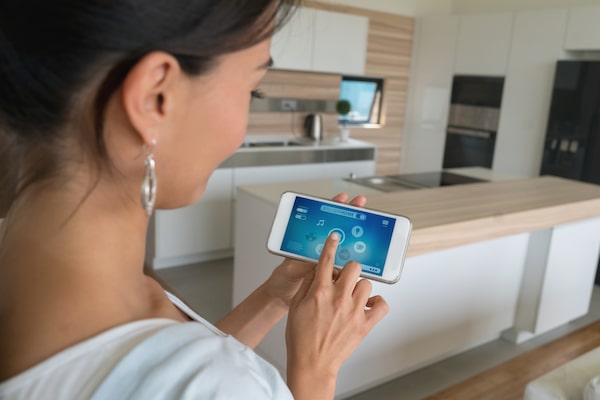
Condo developers have started incorporating smart features in their buildings as a selling point for would-be buyers.andresr/iStockPhoto / Getty Images
With a few quick taps on his mobile phone, Mark Nourani can program the temperature and humidity in his home, adjust the pool heater, check on his toddler and see who’s at his front door. He and his physician wife Jacqueline never come home to a dark house. Their exterior lights come on as dusk sets in and motion sensors activate interior lighting as they walk inside.
Before building their 3,500-square-foot house in North York in 2017, Mr. Nourani did extensive research and to find smart home features that would help save money on energy use and keep their home secure.
“What was important for me was making sure it fit within the budget and that I could manage it personally,” says Mr. Nourani, who works in the fashion industry. “The more technical it is, the more difficult it is to manage.”
Mr. Nourani chose a Lutron platform to control his smart home features, a brand available at big box stores. (He uses a Pro version geared to residential contractors, but he says the consumer versions also work well). Mass market brands are easy to upgrade and expand with third-party hardware and software, he explains.
“I use stuff that’s very simple,” Mr. Nourani says. “I can program and control the settings easily through my phone.”
When he and his wife aren’t at home, in-house cameras allow them to use their phones to check on their son and his caregiver. They can see who comes to the front door, talk to them and allow access remotely.
The system also allows Mr. Nourani to set times for “good morning” or “good night” scenes, so specific music plays on the whole-house sound system, blinds raise or lower and lights dim or brighten.
“But I don’t use it to turn on the coffee maker,” he notes.
Mr. Nourani isn’t alone in his quest to live in a more intelligent abode. Market intelligence firm International Data Corporation predicts that the global smart home market, which saw 833 million smart home devices ship in 2018, will grow by 26.9 per cent in 2019. It’s a trend that’s on the rise as technology has made smart home features more inexpensive and accessible.
Mr. Nourani estimates a system similar to his could be installed for $1,000. He suggests motion sensors and timers as the most practical, energy-saving features to include.
“Those things are not so new school and I’m shocked they aren’t used more widely,” he says. “You can put [motion sensors] anywhere you need light, even closets and pantries, and program them to turn off after two minutes.”
Condo developers have started incorporating smart features in their buildings as a selling point for would-be buyers.
At Toronto’s first smart condo building, Tridel’s Ten York, residents use a wall pad, similar to a tablet, to perform functions such as controlling their suite’s temperature, setting the security alarm and communicating with the concierge. They can also see who is arriving at the front door and let them in. There is no need for keys: Doors have keyless digital locks or residents can unlock their door with a smart phone app. License plate recognition means that the garage door opens as residents approach in their cars. The building has its own fibre optics and smart network to provide excellent connectivity and ultra-fast Internet.
“We studied what we could do in a high-rise condo environment that would make it easier for residents to do things in their home,” says Jim Ritchie, Tridel vice-president of sales and marketing. “The premise is to make people’s lives more convenient and enhance their enjoyment. It has to be of benefit, not just something that’s cool.”
All Tridel buildings from now on will have ‘Tridel Connect’ technology, Mr. Ritchie says. He notes that automated parcel delivery has been “a big hit” with Ten York buyers. The delivery person enters the parcel storage area, scans the package and a locker opens to accept it. Recipients receive a text saying their package has arrived. Photos are taken of the delivery person and whoever picks it up as an added security measure.
While such features do come with a cost, Mr. Ritchie says these costs are included in residents’ condo fees. He notes that smart solutions will be tailored to individual buildings in the future, evolving as technology improves and consumer needs change. For example, there may not be a need for in-suite wall pads if people prefer to control everything by smartphone.
Ontario-based homebuilder Mattamy Homes is also in the smart home game – the company is constructing smart home models that will serve as innovation labs where different technologies are tried and tested.
Last year, Mattamy Homes started including voice-enabled Ecobee4 smart thermostats in every new build. The thermostat includes a built-in Amazon Alexa, a virtual assistant that allows homeowners to control things like lights or blinds with their voice.
Homeowners don’t have to use voice automation with their thermostat though, says Brent Carey, vice-president of communications for Mattamy Homes. They can instead control the thermostat with a computer or smartphone, or they can rely on the thermostat’s room sensor which manages room hot and cold spots on its own.
The idea is to provide homeowners with options that suit their needs and lifestyles, Mr. Carey says.
“It’s not a one-size-fits-all approach.”